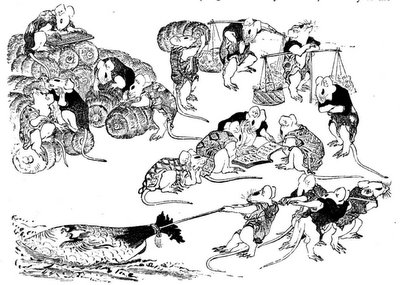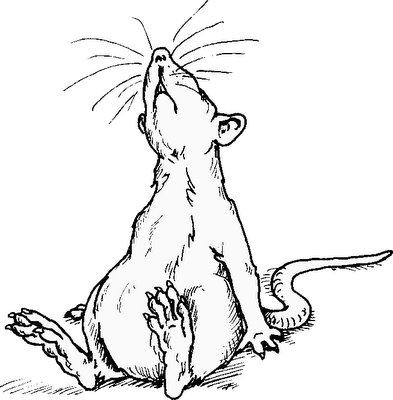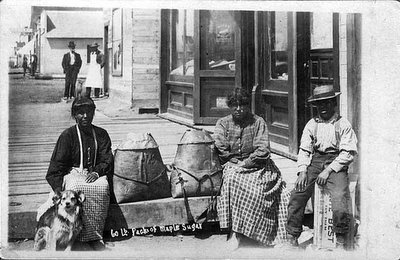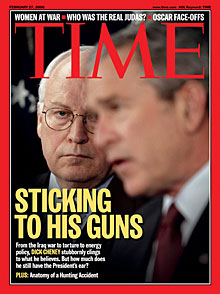Posted by
puddle
at
2/28/2006 06:39:00 pm
0
comments
![]()
Do I dare to eat a peach?

So who are the winners from rising inequality? It's not the top 20 percent, or even the top 10 percent. The big gains have gone to a much smaller, much richer group than that.
A new research paper by Ian Dew-Becker and Robert Gordon of Northwestern University, "Where Did the Productivity Growth Go?," gives the details. Between 1972 and 2001 the wage and salary income of Americans at the 90th percentile of the income distribution rose only 34 percent, or about 1 percent per year. So being in the top 10 percent of the income distribution, like being a college graduate, wasn't a ticket to big income gains.
But income at the 99th percentile rose 87 percent; income at the 99.9th percentile rose 181 percent; and income at the 99.99th percentile rose 497 percent. No, that's not a misprint.
Just to give you a sense of who we're talking about: the nonpartisan Tax Policy Center estimates that this year the 99th percentile will correspond to an income of $402,306, and the 99.9th percentile to an income of $1,672,726. The center doesn't give a number for the 99.99th percentile, but it's probably well over $6 million a year.
Why would someone as smart and well informed as Mr. Bernanke get the nature of growing inequality wrong? Because the fallacy he fell into tends to dominate polite discussion about income trends, not because it's true, but because it's comforting. The notion that it's all about returns to education suggests that nobody is to blame for rising inequality, that it's just a case of supply and demand at work. And it also suggests that the way to mitigate inequality is to improve our educational system - and better education is a value to which just about every politician in America pays at least lip service.
The idea that we have a rising oligarchy is much more disturbing. It suggests that the growth of inequality may have as much to do with power relations as it does with market forces. Unfortunately, that's the real story.
Should we be worried about the increasingly oligarchic nature of American society? Yes, and not just because a rising economic tide has failed to lift most boats. Both history and modern experience tell us that highly unequal societies also tend to be highly corrupt. There's an arrow of causation that runs from diverging income trends to Jack Abramoff and the K Street project.
And I'm with Alan Greenspan, who - surprisingly, given his libertarian roots - has repeatedly warned that growing inequality poses a threat to "democratic society."
Edwin, ♥s
Posted by
puddle
at
2/27/2006 01:53:00 pm
0
comments
![]()

Sitting at this window on Avenue C, a tree (many actually, but there is a main, nearest, one) very like this. Changes throughout the day. Just now, in shadow, looking almost black against the pale blue and white of the sky between the red brick buildings that surround the court. Further down the walk, a break between building lets the sunshine flood the walkway, and the trees there look like white lace. So black lace laying over white lace laying over blue tinged thin clouds.
Watching this tree, this court, this walkway, change through the day is a pleasure on no inconsiderable consequence.
Last week stopped to sit a bit on the benches looking across the tennis courts, and heard a puffy trilling sound behind me. Turned to watch a pigeon courtship taking place: he ~~ all puffed up about the neck and chest, strutting and gurgling for his lady's pleasure; she ~~ ostentatiously more interested in finding a bit of food among the gravel. He was not successful.
Then yesterday, a pair of doves in the tree. He sidling up to her, her moving, till finally he sidled her off the end of the branch. Alas also, not successful, but I have to admit all the courting behavior within my sight gives me enormous hope that spring is just around the corner, even as the temperatures are dropping into the teens nightly, and the wind whips through the canyons of brick.
Posted by
puddle
at
2/27/2006 01:15:00 pm
0
comments
![]()

Red Houses
for Frances
There are in this country, off small roads in darkness,
certain red houses.
Not the red of blood but the red of fire:
red from the red women who live in them.
I have been in one such house.
There was nothing special, nothing to show.
The wooden gates stood open, the dogs were in,
and on the raw concrete steps a bicycle
sprawled on its side in the thick black night air
that laid its wet finger to my face. Inside
the dark-haired red woman-of-the-house
stood by the table, pulled all eyes to her, and it was not
what she said, or did, or looked like, but the place
she drew her life from (some old ferned well
whose whereabouts I did not know) which so tuned her
that she glowed the house.
Fear for the children of such women,
especially the sons. For if they miss
the moment when it might be possible
to make the thing over again
they will spend their lives searching
through people and countries
and nowhere will they find again the red house
with the red heart in the soft black rainy night.
Posted by
puddle
at
2/26/2006 02:21:00 pm
3
comments
![]()
Posted by
puddle
at
2/25/2006 06:12:00 pm
1 comments
![]()

So why did this latest case of sloppiness and indifference finally catch the public's attention? Because this time the administration has become a victim of its own campaign of fearmongering and insinuation.
Let's go back to the beginning. At 2:40 p.m. on Sept. 11, 2001, Donald Rumsfeld gave military commanders their marching orders. "Judge whether good enough hit S. H. [Saddam Hussein] @ same time - not only UBL [Osama bin Laden]," read an aide's handwritten notes about his instructions. The notes were recently released after a Freedom of Information Act request. "Hard to get a good case," the notes acknowledge. Nonetheless, they say: "Sweep it all up. Things related and not."
So it literally began on Day 1. When terrorists attacked the United States, the Bush administration immediately looked for ways it could exploit the atrocity to pursue unrelated goals - especially, but not exclusively, a war with Iraq.
But to exploit the atrocity, President Bush had to do two things. First, he had to create a climate of fear: Al Qaeda, a real but limited threat, metamorphosed into a vast, imaginary axis of evil threatening America. Second, he had to blur the distinctions between nasty people who actually attacked us and nasty people who didn't.
The administration successfully linked Iraq and 9/11 in public perceptions through a campaign of constant insinuation and occasional outright lies. In the process, it also created a state of mind in which all Arabs were lumped together in the camp of evildoers. Osama, Saddam - what's the difference?
Now comes the port deal. Mr. Bush assures us that "people don't need to worry about security." But after all those declarations that we're engaged in a global war on terrorism, after all the terror alerts declared whenever the national political debate seemed to be shifting to questions of cronyism, corruption and incompetence, the administration can't suddenly change its theme song to "Don't Worry, Be Happy."
There's more: click title. . . .
Hat tip to The O C
Posted by
puddle
at
2/24/2006 09:47:00 pm
2
comments
![]()
Anonymous said...
That story is a little old. you must be slacking.
7:38 AM, February 24, 2006
You could say that. I wouldn't necessarily agree ~~
This is the SO-CALLED LIBERAL MEDIA'S take on it. . . .
Gonzales seeks to reframe NSA surveillance
Miami Herald, FL - Jan 24, 2006
... Before his appearance at Georgetown, Gonzales said in a television interview that some congressional leaders told the administration in 2004 that it would not ...
Gonzales: Surveillance of al-Qaida is essential
Arizona Daily Star, AZ - Jan 24, 2006
... Before his appearance at Georgetown, Gonzales said in a TV interview that congression-al leaders told the administration in 2004 it would not be possible to ...
Attorney general defends wiretaps
Minneapolis Star Tribune (subscription), MN - Jan 24, 2006
... on a Benjamin Franklin quote, read: "Those who would sacrifice liberty for security deserve neither." Before his appearance at Georgetown, Gonzales said in a ...
or this:
Gonzales Invokes Actions of Other Presidents in Defense of U.S. Spying
*Please Note: Archive articles do not include photos, charts or graphics. More information.
January 25, 2006, Wednesday
By ERIC LICHTBLAU (NYT); National Desk
Late Edition - Final, Section A, Page 19, Column 1, 1161 words
DISPLAYING FIRST 50 OF 1161 WORDS -Ramping up the administration's defense of its domestic eavesdropping program, Attorney General Alberto R. Gonzales on Tuesday invoked the lessons of George Washington and Franklin D. Roosevelt in justifying President Bush's broad power to wage war against terrorism. Mr. Gonzales, an architect of the surveillance program, said that the...
To read the rest of this archive article, upgrade to TimesSelect or purchase as a single article.
Fox News ( http://www.foxnews.com/story/0,2933,182652,00.htm ) had one 40-word paragraph about the protest.
Posted by
puddle
at
2/24/2006 04:59:00 pm
2
comments
![]()
Today marks the beginning of Maple season for me. I will clean the leaves and debris from the stone stacked fire hearth I built, lay dry wood in, and sit the stainless steel pan down. Soon the pan will begin to ping as the sap heats up. And that will continue as I add more and more sap. About 6 hours for today's boil, plus an hour in the kitchen finishing.
I would also like to share this.
The traditional Ojibwa people read the weather and the woods the way we read books today. They watched the animal tribes and the bird tribes and the twigs and the soil. At ishpibiboon, the time when the bald eagles returned in the spring, they knew it would soon be time to harvest ziinzibaakwadwaaboo, sap, from anininaatig, the maple, the tree of inini, the human being.
From Sugartime by Susan Carol Hauser
Shadow*TeaTimeTim | 02.24.06 - 9:47 am
Posted by
puddle
at
2/24/2006 12:48:00 pm
1 comments
![]()

On January 24, 2006, Attorney General Alberto Gonzales spoke at Georgetown University's law school and attempted to defend the Administration's position that warrantless wiretaps authorized by President Bush do not violate the Constitution or federal law
At 10:30 a.m. Gonzales entered the room and Dean T. Alexander Aleinikoff introduced him. While people were applauding and Gonzales took the podium, two women in the second row got up and turned their backs on Gonzales. Both women had the words "Tap This!" on their butts, and one had a "I (heart) the Bill of Rights" sign stuck to her back. The words could be read from the stage, so Gonzales got the message.
Gonzales began speaking. As he spoke, other students stood and turned their backs. Then a group in the back row stood up with black hoods on and held the banner with "Those who would sacrifice liberty for security deserve neither" up to the cameras. It was beautiful.
Every few minutes more students stood and turned their backs, including some who had not known any protest would be taking place, but chose to stand in solidarity with us and to stand up against Gonzales. It was strong and beautiful resistance. Over 30 students stood and turned their backs on Gonzales as he tried to justify spying on Americans.
Several students walked out on him before the end of his speech.
During the panel discussion after the speech, Georgetown University Law Professor David Cole said, "When you're a law student, they tell you if say that if you can't argue the law, argue the facts. They also tell you if you can't argue the facts, argue the law. If you can't argue either, apparently, the solution is to go on a public relations offensive and make it a political issue... to say over and over again "it's lawful", and to think that the American people will somehow come to believe this if we say it often enough. In light of this, I'm proud of the very civil civil disobedience that was shown here today."
All in all, it was a good day for dissent.
The organizers of the event are putting together a website where they're hoping to build a grassroots coalition of law students, professors, and citizens to counter the Administration's campaign of empty legal claims.
From an email. Thanks Edwin ♥s
Posted by
puddle
at
2/23/2006 10:18:00 pm
4
comments
![]()

humble pie
A 17th century English dish, in which the heart, liver, kidney and other innards of a deer were combined with apples, currants, sugar and spices and baked as a pie. The servants ate this inexpensive but filling repast while the gentry dined on the VENISON. The name comes from the old-English word numble , meaning a deer's innards. "A numble pie" became "an umble pie," which eventually worked it's way to "a humble pie."
Posted by
puddle
at
2/22/2006 04:37:00 pm
0
comments
![]()

Gov. Jeb Bush said he has faith in his brother's administration over its decision to allow an Arab-owned company to operate major U.S. ports, including in Miami.
Dubai Ports World, a state-owned business in the United Arab Emirates, is expected to take over a British company that has been running six U.S. ports.
Posted by
puddle
at
2/21/2006 07:33:00 pm
1 comments
![]()

Bush, Cheney have 1,000 days to get administration back on track
Sunday, February 19, 2006; Posted: 11:00 p.m. EST (04:00 GMT)
Editor's note: The following is a summary of this week's Time magazine cover story.
The shooting accident brought into focus the extent to which Dick Cheney runs an independent operation.
(Time.com) -- For an entire week, the Bush administration has been tangled in the aftermath of the Cheney hunting accident. That might not seem like a long time, but Bush and Cheney have barely over 1,000 days left and things they want to get done.
To succeed, they need to resist as long as possible the forces that make administrations irrelevant. "Some people in the White House are worried that this will hasten the start of the formal lame-duck period, which they were hoping to put off until after the midterm elections," said a Republican official. "This showed a weakened president and a vice president in a bubble within a bubble."
And according to a new Time poll, Bush's approval rating is lodged at 40 percent, Cheney's at 29 percent. Bush and Cheney have little hope of driving an agenda if they are not in control of it or if they are playing defense. (Time poll: Cheney's latest stats)
What the hunting furor did, beyond occupying the airwaves for a week and stalling what momentum the president may have had, was expose in the most public way yet the extent to which Cheney runs an independent operation and raise the question of how much the White House can control him -- or wants to.
For the rest: click title
Hat tip to WTF is it now??
Posted by
puddle
at
2/20/2006 07:47:00 pm
1 comments
![]()

Work like you don't need the money.
Love like you've never been hurt.
Dance like nobody's watching.
Sing like nobody's listening.
Live like it's Heaven on Earth.
Posted by
puddle
at
2/20/2006 04:56:00 pm
0
comments
![]()

Dear Mr. God,
Sometimes it's very hard to understand your plan.
It would be civil of you to give us a hint or two.
For instance, what exactly is the use of liver cancer in babies? And what good, exactly, that this family should experience it twice in one lifetime?
A few words on the subject would be appreciated.
Sincerely,
Your friend
Posted by
puddle
at
2/18/2006 10:22:00 pm
5
comments
![]()

This is one very very sick little boy, and he belongs to people that I love dearly.
♥
(That is his grandfather, my next to youngest brother, in the background.)
Posted by
puddle
at
2/18/2006 09:44:00 pm
0
comments
![]()

This is a new trend for the White House: rendering an illegal act legal retroactively by fiat. The trend manifested itself in another area of illegal activity by the White House, the warrantless wiretapping of thousands of American citizens by the National Security Agency, in defiance of the black-letter law contained within the Foreign Intelligence Surveillance Act of 1978. For several weeks now, Congress has been threatening to hold hearings on the matter. Bush advisor Karl Rove worked feverishly behind the scenes to keep such hearings from taking place, and has succeeded. Rather than investigate the matter, Congress will instead rewrite the FISA law, thus rendering retroactively legal White House activities that blatantly broke the law.
We hear a great deal about enemies these days, and many of them are quite real and quite perilous. It is difficult to imagine a more perilous enemy, however, than the one operating out of Washington today. This enemy would set itself on high, beyond control or censure, and create of itself that permanent faction James Madison so earnestly warned us of. This enemy deletes or hides evidence of its calumny, or simply alters existing laws that would otherwise derail its plans. This enemy destroys lives out of hand, lives by the tens of thousands, and reaps a pretty profit in the process.
The difference between the enemies we hear about and the one in Washington is simple and deadly: only the enemy in Washington can annihilate the constitutional government we have enjoyed for more than two centuries. The idea that is America cannot be terminated by terrorists or rogue states. Were the nation entire to be somehow obliterated, the idea that is America would endure. Only its keepers can kill it completely. They are well on their way.
"As nightfall does not come at once," wrote Justice William O. Douglas, "neither does oppression. In both instances, there's a twilight where everything remains seemingly unchanged, and it is in such twilight that we all must be aware of change in the air, however slight, lest we become victims of the darkness."
We must deal with the enemy within the halls of our government, the enemy whose power to destroy far outstrips any enemy beyond our borders. In doing so, we save that which is unique in the world. In doing so, we deal a death blow to all other enemies. In doing so, we save ourselves from that darkness.
~~ William Rivers Pitt
Thanks seashell ♥
Posted by
puddle
at
2/17/2006 08:56:00 pm
0
comments
![]()

Congratulations. Since we launched www.NedLamont.com more than 1,000 people from Connecticut have signed up to volunteer, giving us the beginnings of the ground army we need to launch our campaign. During the next few weeks a team of volunteers will be individually contacting each volunteer from Connecticut who signed up and get you involved in specific campaign activities.
Because of your enthusiasm I have established a candidate committee and am in the process putting together a great campaign team.
I will formally announce my candidacy in March -- but first we need to do some more work. Joe Lieberman has already raised over $5 million and not surprisingly Republican lobbyists in Washington DC, including George H.W. Bush's former Chief of Staff, are stepping up to raise money for the Senator that was voted the most popular Democrat amongst lobbyists and Republicans in the National Journal's annual poll.
In addition to what I will contribute, it will cost $500,000 to launch this campaign and we need to begin right now. You can make a secure contribution directly to my campaign on my Act Blue page.
http://www.nedlamont.com/actblue.html
Posted by
puddle
at
2/16/2006 09:00:00 pm
0
comments
![]()
Posted by
puddle
at
2/16/2006 07:30:00 pm
3
comments
![]()

. . . .a photograph that began popping up on Web sites yesterday, of what seems to be a toilet floor covered with blood and litter, framed by a small glimpse of tiled walls. It suggests a bathroom turned into a holding cell, or perhaps a scene from a hospital or triage center, or a torture chamber. The blood on the floor instantly suggests the splatter and drip paintings of the abstract expressionists.
Newspapers have often turned to blood as a substitute for violence, showing photographs of the gore that lingers on streets long after the bodies -- too graphic to show -- have been cleared away. Here, in a photo that contains no particular information, no names, no certainty even about whether it shows what it seems to show, is the blood image in a new form. This is no substitute, no polite euphemism for what can't be shown. Blood as a substitute for death deflects horror; this blood demands answers.
Comparing blood to paint, violence to art, is dangerous, even repellent. But in one sense, the blood on this floor is exactly like the paint drippings of Jackson Pollock, who captured the visible traces of action, the visual memory of gestures. In Pollock's painting, the gestures fixed on canvas were often graceful, melodic even, with paint obeying the law of gravity with a gentle quiescence. If this is blood, we can only imagine what the gestures were.
What's powerful, and infinitely sad, about this bloody floor is the silence. Whatever happened in this room, it almost certainly was accompanied by a cacophony of pain. That's gone now. As is anyone involved with what happened there. The garbage on the floor, the opening of a toilet, suggest human beings reduced to refuse. The anonymity of those who may have suffered is absolute. Other photographs have appeared with faces decorously blacked out, a nod by those publishing the images to the dignity of the victims. Here, everything has been blotted out, and strangely enough, the dignity is now complete.
The victim is now just blood, there is no face to put on him or her, nothing we can say about what or where the wounds were, and how they happened. And in this abstraction from anything identifiable, the victim becomes completely, finally Human, not a particular man or woman, with a certain color of skin, or cut of hair, or any clothing to place him or her in the categories that we use to make sense of the faraway, the foreign or the frightening. The abstraction of blood leaves an open space for anyone looking at this picture to imagine himself or herself in its midst, to imagine, say, that the blood pooling on the floor like wax before it drains to the opening of a rank toilet is our own. And that these dull industrial tiles, with their insidious repetition of a pattern, are the last things we remembered before the lights went out.
Those who deplore the release of these images are right in that they may add no specific new evidence to a forensic or political or journalistic argument. And they draw us -- no, wrench us -- further from what Americans like to think of as "closure," the end of the shame, the end of the argument. But this one image, just a pattern of darkness on a canvas of cement and tile, opens up everything, because who can look at it without going there? If the original Abu Ghraib photographs compelled us to realize our connection to the perpetrators -- our soldiers, fighting our war -- this sad, silent image begs us to at least imagine that we are connected, in a deeper, human way, to the victims.
Picture in question at original ~~ click title
Hat tip to The O C
Posted by
puddle
at
2/16/2006 03:06:00 pm
2
comments
![]()
